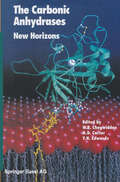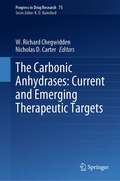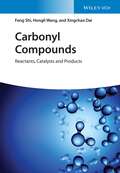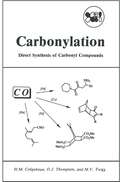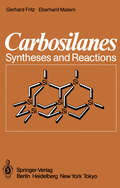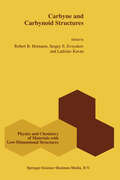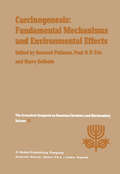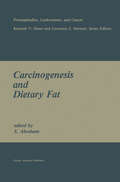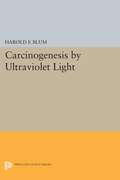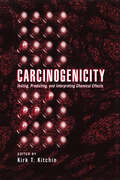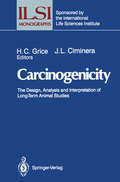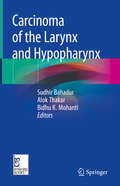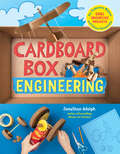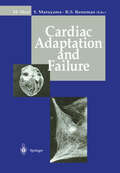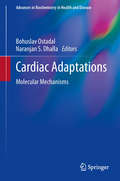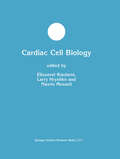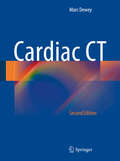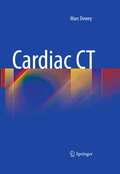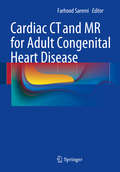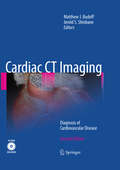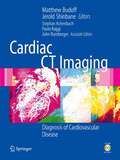- Table View
- List View
The Carbonic Anhydrases: New Horizons (Experientia Supplementum #90)
by W. R. Chegwidden N. D. Carter Y. H. EdwardsCarbonic anhydrase (CA) is a seemingly ubiquitous enzyme of profound physiological importance, which plays essential roles in respiration, acid-base homeostasis, bone resorption, calcification, photosynthesis, several biosynthetic pathways and a variety of processes involving ion, gas and fluid transfer. This enzyme, which is present in at least three gene families (a, ß, ?), has found favour as a model for the study of evolution of gene families and for site-directed mutagenesis in structure/function relationships, for protein folding and for transgenic and gene target studies. Since the early use of CA inhibitors as diuretics and in treating congestive heart failure, the enzyme has been target of considerable clinical attention. Much of this is now focused on endeavours to produce a new generation of such drugs for the effective treatment of glaucoma and other potential applications. Recent data, suggesting links between CA and various disease processes, including cancer, have stimulated further...
The Carbonic Anhydrases: Current and Emerging Therapeutic Targets (Progress in Drug Research #75)
by W. Richard Chegwidden Nicholas D. CarterThis volume assembles and integrates the wealth of diverse information that is now accumulating in this burgeoning field. The existing and potential therapeutic applications of targeting CA cover a remarkably wide-range of diseases and disorders and have generated increasing and extensive interest in recent years. Its inter-disciplinary approach embraces both the most up-to-date therapeutic application of CA-targeting and the latest research data that will provide a platform for the development of novel applications. The interested audience comprises scientists and clinicians from many relevant disciplines within science and medicine.
Carbonyl Compounds: Reactants, Catalysts and Products
by Feng Shi Hongli Wang Xingchao DaiCarbonyl Compounds Discover how carbonyl compounds bridge reactants, catalysts, and specific products Carbonyl-containing molecules represent some of the most versatile functionalities in organic chemistry, with applications in a wide variety of areas. In Carbonyl Compounds: Reactants, Catalysts and Products, accomplished chemists and authors Feng Shi, Hongli Wang, and Xingchao Dai deliver a comprehensive treatment of these multi-functional compounds. You’ll discover how to build carbonyl molecules with traditional and non-traditional methods, how to transform carbonyl-containing molecules into fine chemicals, and how to use carbonyl-containing molecules as catalytic materials for the synthesis of fine chemicals. The book is a comprehensive and systematic treatment of carbonyl compounds as reactants, catalysts, and products. From the use of carbon monoxide in the hydroformylation of alkenes and alkynes to the reactions via carbonyl and hydroxyl groups recycling, you’ll find everything you need to know about these versatile compounds. Readers will also benefit from the inclusion of: A thorough introduction to carbonyl molecules as reactants, including treatments of carbon monoxide, carbon dioxide, HCHO, HCOOH, and CO surrogates An exploration of carbonyl compounds as catalysts, including acid catalyzed reactions with -CO2H and reactions via carbonyl and hydroxyl groups recycling A practical discussion of the synthetic applications of carbonyl compounds, including the synthesis of functional molecules and the synthesis of functional materials A concise treatment of future perspectives and potential research trends for carbonyl molecules Perfect for organic, catalytic, pharmaceutical, and physical chemists, Carbonyl Compounds will also earn a place in the libraries of chemical engineers and materials scientists seeking a one-stop reference for up-to-date information about the building, transformation, and applications of carbonyl-containing molecules.
Carbonyl Compounds: Reactants, Catalysts and Products
by Feng Shi Hongli Wang Xingchao DaiCarbonyl Compounds Discover how carbonyl compounds bridge reactants, catalysts, and specific products Carbonyl-containing molecules represent some of the most versatile functionalities in organic chemistry, with applications in a wide variety of areas. In Carbonyl Compounds: Reactants, Catalysts and Products, accomplished chemists and authors Feng Shi, Hongli Wang, and Xingchao Dai deliver a comprehensive treatment of these multi-functional compounds. You’ll discover how to build carbonyl molecules with traditional and non-traditional methods, how to transform carbonyl-containing molecules into fine chemicals, and how to use carbonyl-containing molecules as catalytic materials for the synthesis of fine chemicals. The book is a comprehensive and systematic treatment of carbonyl compounds as reactants, catalysts, and products. From the use of carbon monoxide in the hydroformylation of alkenes and alkynes to the reactions via carbonyl and hydroxyl groups recycling, you’ll find everything you need to know about these versatile compounds. Readers will also benefit from the inclusion of: A thorough introduction to carbonyl molecules as reactants, including treatments of carbon monoxide, carbon dioxide, HCHO, HCOOH, and CO surrogates An exploration of carbonyl compounds as catalysts, including acid catalyzed reactions with -CO2H and reactions via carbonyl and hydroxyl groups recycling A practical discussion of the synthetic applications of carbonyl compounds, including the synthesis of functional molecules and the synthesis of functional materials A concise treatment of future perspectives and potential research trends for carbonyl molecules Perfect for organic, catalytic, pharmaceutical, and physical chemists, Carbonyl Compounds will also earn a place in the libraries of chemical engineers and materials scientists seeking a one-stop reference for up-to-date information about the building, transformation, and applications of carbonyl-containing molecules.
Carbonylation: Direct Synthesis of Carbonyl Compounds
by H.M. Colquhoun D.J. Thompson M.V. TwiggSince the publication of our earlier book on transition metal mediated organic synthesis, * there has been a widespread increase of interest in this topic, and transition metal based methodology has become firmly established in many areas of organic chemistry. The direct, catalytic formation of organic carbonyl compounds using carbon monoxide as the source of the carbonyl group has seen exceptional progress, and this carbonylation chemistry is being used increasingly in research and on a larger scale for fine chemicals production. In view of these developments, there is a need for a modem, practi cally oriented book dealing with transition metal based carbonylation chemistry. The present monograph should help fulfill this need, since it is intended specifically to foster the adoption of catalytic carbonylation as a general tool in synthetic organic chemistry. It deals exclusively with reactions involving the interconversion of carbon monoxide and organic carbonyl compounds, and although the majority of the reactions discussed involve catalytic formation of carbonyl compounds, potentially valuable syntheses requiring stoichiometric quantities of transition metal are also included. In addition, a chapter is devoted to the remarkably useful reverse transformation (decarbonylation), in which an organic carbonyl group is eliminated in the form of carbon monoxide.
Carbosilanes: Syntheses and Reactions
by Gerhard Fritz Eberhard MaternCarbosilanes are compounds in which the elements silicon and carbon alternate in the molecular skeleton [1]. Just as the alkanes are formally derived from the diamond lattice and the aromatics from the graphite lattice, the carbosilanes are structurally derived from silicon carbide. Because of the tetravalent nature of silicon and carbon we can expect stable linear, cyclic and polycyclic compounds to occur. However, carbosilanes do not exist in nature. This book is an attempt to give a summarized presentation. Carbosilanes are, of course, part" of organosilicon chemistry, but their behavior differentiates them distinctly from other organosilicon compounds. The differences result primarily from the alternating Si-C-Si arrangements in the molecular skeleton, and especially the various methylene bridges (CH , CHX, CX ; X = halogen) cause changes in z z Si-C bond polarization and hence influence the reaction possibilities. It is convenient to regard carbosilanes as similar to silicones except that the oxygen bridges of silicones are replaced by methylene units. However, this does not accurately account for all the chemical properties of these compounds. Carbosilanes are related more directly to silicon carbide, as shown occasionally by the reactive behavior of polycyclic car bosilanes. Therefore, in view of the present interest shown for thermally stable cera mics of unusual character, interesting possibilities arise for further development. Most cyclic carbosilanes can be classified in two groups: the carborundanes and the Si-scaphanes. Compounds belonging to the carborundane class maintain Si-C six-membered rings in the boat conformation.
Carburising and Nitriding of Iron Alloys (Physical Chemistry in Action)
by Emilia Wołowiec-KoreckaThis monograph is a comprehensive exploration of the thermochemical treatment of iron alloys, focusing specifically on quenching, carburising, and nitriding. The book introduces the importance of materials engineering in the context of contemporary societal needs and delves into the historical development of thermochemical treatment over the centuries. The global challenges facing thermochemical treatment are also outlined while the three primary development trends identified in the literature at the beginning of the 21st century: reducing thermal deformation in mass production, process modelling, and a multifactorial reduction of treatment costs are also reviewed. Finally, a detailed discussion on the significance of computational methods in advancing thermochemical treatment is included. The book provides a detailed examination of thermochemical treatment processes and their evolution and is a useful tool for graduates, researchers, and professionals working in the area of materials engineering.
Carbyne and Carbynoid Structures (Physics and Chemistry of Materials with Low-Dimensional Structures #21)
by R. B. Heimann S. E. Evsyukov Ladislav KavanThis is a book on one of the most fascinating and controversial areas in contemporary science of carbon, chemistry, and materials science. It concisely summarizes the state of the art in topical and critical reviews written by professionals in this and related fields.
Carcinogenesis: Proceedings of the Thirteenth Jerusalem Symposium on Quantum Chemistry and Biochemistry Held in Jerusalem, Israel, April 28 – May 2, 1980 (Jerusalem Symposia #13)
by A. Pullman Paul O. P. Ts'O H. GelboinProceedings of the 13th Jerusalem Symposium on Quantum Chemistry and Biochemistry held in Jerusalem, Israel, April 28-May 2, 1980
Carcinogenesis by Ultraviolet Light (PDF)
by Harold Francis BlumThis book represents the culmination of over fifteen years of experimental and theoretical studies aimed at the elucidation of the process by which ultraviolet light induces cancer. In so far as possible the subject matter is treated from a quantitative point of view, whether dealing with the effects of ultraviolet light on isolated cells or on more integrated systems including the induction of cancer. A description of the course of carcinogenesis by ultraviolet light is presented, based on experimental data, in which cancer is treated as a growing tissue mass. This constitutes probably the most complete summary of a cancer process formulated up to this time.Originally published in 1959.The Princeton Legacy Library uses the latest print-on-demand technology to again make available previously out-of-print books from the distinguished backlist of Princeton University Press. These editions preserve the original texts of these important books while presenting them in durable paperback and hardcover editions. The goal of the Princeton Legacy Library is to vastly increase access to the rich scholarly heritage found in the thousands of books published by Princeton University Press since its founding in 1905.
Carcinogenicity: Testing: Predicting, and Interpreting Chemical Effects
by Kirk T. KitchinOffers comprehensive coverage of currently available cancer predictors, the most recent research on carcinogenicity, and the design and interpretation of carcinogenicity experiments. Presents mouse, rat, and human carcinogenicity data for the liver, kidney, breast, cervix, prostate, hematopoietic system, colon, skin, urinary bladder, mouth, stomach, thyroid, and pancreas.
Carcinogenicity: Testing: Predicting, and Interpreting Chemical Effects
by Kirk T. KitchinOffers comprehensive coverage of currently available cancer predictors, the most recent research on carcinogenicity, and the design and interpretation of carcinogenicity experiments. Presents mouse, rat, and human carcinogenicity data for the liver, kidney, breast, cervix, prostate, hematopoietic system, colon, skin, urinary bladder, mouth, stomach, thyroid, and pancreas.
Carcinogenicity: The Design, Analysis, and Interpretation of Long-Term Animal Studies (ILSI Monographs)
Critical issues in the design, evaluation and interpretation of long-term animal carcinogenicity studies are addressed in this volume. The presentations are by top pathologists, toxicologists and statisticians in the USA, Canada and Europe, representing industry, academia and regulatory agencies. The discussions involve controversial as well as conventional issues and are presented from statistical and biological or toxicological perspectives. Although more work has been done and published on long-term animal carcinogenicity studies than in any other phase of chemical or drug safety assessment, many issues still remain unresolved. Some solutions have been proposed, but in many instances they have not proven to be completely remedial. This volume continues important discussion of these issues and proposed solutions, and should be of interest to scientists engaged in long-term animal carcinogenicity testing.
Carcinoma of the Larynx and Hypopharynx
by Sudhir Bahadur Alok Thakar Bidhu K. MohantiCarcinomas of the larynx and hypopharynx present unique challenges when it comes to their assessment and management. Management involves the essential dilemma of optimizing cure rates while also ensuring that potential disability due to compromised airway, voice and swallowing is minimized. Treatment decisions involve careful disease assessment, judicious multispecialty decision-making, and subsequent meticulous implementation of the selected treatment modalities.The critical nature of each of these steps has led to dramatic advances in assessment techniques (radiology, endoscopy and photography, stroboscopy, narrow band imaging, contact endoscopy) and also in treatment methods (radiation therapy, combined concurrent chemo-radiation, combined sequential chemo-radiation, trans-oral CO2 laser and robotic surgery, partial laryngectomy, total laryngectomy, extended total laryngectomy). As such, treatment decisions have become increasingly complex with the twin objectives of maximizing cure as well as function preservation and are based on tumor stage, tumor location, systemic co-morbidities, nutritional status, patient priorities, and social and economic factors. This multidisciplinary book has been written by a team of editors with considerable experience and expertise in these critical areas and a deep understanding of teamwork and the strengths and limitations of individual technologies and treatments. It presents a homogeneous and unbiased view that is applicable to all specialties involved in the care of larynx and hypopharynx cancers.
Cardboard Box Engineering: Cool, Inventive Projects for Tinkerers, Makers & Future Scientists
by Jonathan AdolphYoung tinkerers and makers will find creative ways to use cardboard boxes, sheets, and tubes in easily-engineered projects, including awesome gadgets, toys, games, inventions, and sculptures.
Cardiac Adaptation and Failure
by Masatsugu Hori Yukio Maruyama Robert S. RenemanAdvances in cellular physiology and molecular biology have now disclosed the metabolic changes and adaptational responses of the heart to various kinds of stresses. Topics covered in this volume include the regulation of myocardial proteins in mechanical overload, the alteration of adrenoceptors in the stressed heart, metabolic adaptation in cardiac hypertrophy, intracellular calcium metabolism in the ischemia-reperfused myocardium, calcium overload as a cause of myocardial stunning, acquisition of ischemic tolerance by ischemic preconditioning, factors that accelerate myocardial injury, and ventricular remodeling in the ischemic heart. As an update of the latest findings in basic cardiology, this book will benefit both researchers and clinical practitioners.
Cardiac Adaptations: Molecular Mechanisms (Advances in Biochemistry in Health and Disease #4)
by Bohuslav Ostadal and Naranjan S. DhallaThis book summarizes present knowledge of different mechanisms involved in the development of positive and negative consequences of cardiac adaptation. Particular attention is paid to the still underestimated adaptive cardiac responses during development, to adaptation to the frequently occurring pressure and volume overload as well as to cardiac changes, induced by enduring exercise and chronic hypoxia. Cardiac Adaptations will be of great value to cardiovascular investigators, who will find this book highly useful in their cardiovascular studies for finding solutions in diverse pathological conditions; it will also appeal to students, fellows, scientists, and clinicians interested in cardiovascular abnormalities.
Cardiac Cell Biology (Developments in Molecular and Cellular Biochemistry #39)
by Elissavet Kardami Larry Hryshko Nasrin MesaeliCardiac cell biology has come of age. Recognition of activated or modified signaling molecules by specific antibodies, new selective inhibitors, and fluorescent fusion tags are but a few of the tools used to dissect signaling pathways and cross-talk mechanisms that may eventually allow rational drug design. Understanding the regulation of cardiac hypertrophy in all its complexity remains a fundamental goal of cardiac research. Since the advancement of adenovirally mediated gene transfer, transfection efficiency is no longer a limiting factor in the study of cardiomyocytes. A limiting factor in considering cell transplantion as a strategy to repair the damaged heart is cell availability at the right time. Cardiac gap junctions, intercellular communication channels that allow electrical and metabolic coupling and play an important role in arrhythmogenesis are now understood to be exquisite sensors of cardiac change. The reports in this volume incLude elegant studies that made use of cutting edge technological advances and many specialized reagents to address these issues.
Cardiac CT
by Marc DeweyCardiac computed tomography (CT) has become a highly accurate diagnostic modality that continues to attract increasing attention. This extensively illustrated book aims to assist the reader in integrating cardiac CT into daily clinical practice, while also reviewing its current technical status and applications. Clear guidance is provided on the performance and interpretation of imaging using the latest technology, which offers greater coverage, better spatial resolution, and faster imaging while also providing functional information about cardiac diseases. The specific features of scanners from all four main vendors, including those that have only recently become available, are presented. Among the wide range of applications and issues discussed are coronary calcium scoring, coronary artery bypass grafts, stents, and anomalies, cardiac valves and function, congenital and acquired heart disease, and radiation exposure. Upcoming clinical uses of cardiac CT, such as hybrid imaging, preparation and follow-up after valve replacement, electrophysiology applications, myocardial perfusion and fractional flow reserve assessment, and plaque imaging, are also explored.
Cardiac CT
by Marc DeweyComputed tomography of the heart has become a highly accurate diagnostic modality that is attracting increasing attention. This extensively illustrated book aims to assist the reader in integrating cardiac CT into daily clinical practice, while also reviewing its current technical status and applications. Clear guidance is provided on the performance and interpretation of imaging using the latest technology, which offers greater coverage, better spatial resolution, and faster imaging. The specific features of scanners from all four main vendors, including those that have only recently become available, are presented. Among the wide range of applications and issues to be discussed are coronary artery bypass grafts, stents, plaques, and anomalies, cardiac valves, congenital and acquired heart disease, and radiation exposure. Upcoming clinical uses of cardiac CT, such as plaque imaging and functional assessment, are also explored.
Cardiac CT and MR for Adult Congenital Heart Disease
by Farhood SaremiThis is the first major textbook to address both computed tomography (CT) and magnetic resonance (MR) cardiac imaging of adults for the diagnosis and treatment of congenital heart disease (CHD). Since the introduction of faster CT scanners, there has been tremendous advancement in the diagnosis of CHD in adults. This is mostly due to the higher spatial resolution of CT compared to MR, which enables radiologists to create more detailed visualizations of cardiac anatomic structures, leading to the discovery of anomalous pathologies often missed by conventional MR imaging. This book is unique in highlighting the advantages of both CT and MR for the diagnosis of CHD in adults, focusing on the complementary collaboration between the two modalities that is possible. Chapters include discussions of case examples, clinical data, MR and CT image findings, and correlative cadaveric pictures. The chapters focus not only on the diagnosis of the primary problem, but also give readers information on visual clues to look for that often reveal associated pathologies. This book appeals primarily to diagnostic and interventional radiologists, as well as cardiologists and interventional cardiologists.
Cardiac CT Imaging: Diagnosis of Cardiovascular Disease
by Matthew J. Budoff Jerold S. ShinbaneCT is an accurate technique for assessing cardiac structure and function, but advances in computing power and scanning technology have resulted in increased popularity. It is useful in evaluating the myocardium, coronary arteries, pulmonary veins, thoracic aorta, pericardium, and cardiac masses; because of this and the speed at which scans can be performed, CT is even more attractive as a cost-effective and integral part of patient evaluation. This book collates all the current knowledge of cardiac CT and presents it in a clinically relevant and practical format appropriate for both cardiologists and radiologists. The images have been supplied by an experienced set of contributing authors and represent the full spectrum of cardiac CT. As increasing numbers have access to cardiac CT scanners, this book provides all the relevant information on this modality. This is an extensive update of the previous edition bringing the reader up-to-date with the immense amount of updated content in the discipline.
Cardiac CT Imaging: Diagnosis of Cardiovascular Disease
by Matthew J. Budoff Jerold S. ShinbaneCT is an accurate technique for assessing cardiac structure and function, but advances in computing power and scanning technology have resulted in increased popularity. It is useful in evaluating the myocardium, coronary arteries, pulmonary veins, thoracic aorta, pericardium, and cardiac masses; because of this and the speed at which scans can be performed, CT is even more attractive as a cost-effective and integral part of patient evaluation. This book collates all the current knowledge of cardiac CT and presents it in a clinically relevant and practical format appropriate for both cardiologists and radiologists. The images have been supplied by an experienced set of contributing authors and represent the full spectrum of cardiac CT. As increasing numbers have access to cardiac CT scanners, this book provides all the relevant information on this modality.
